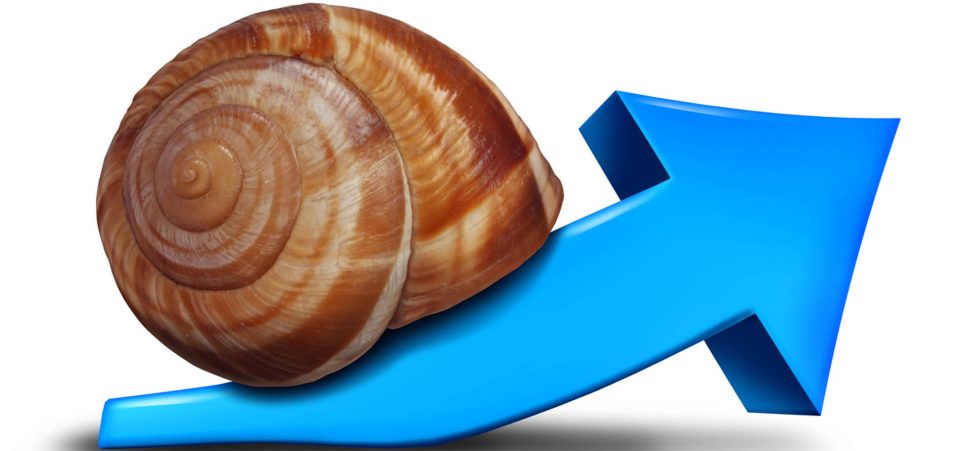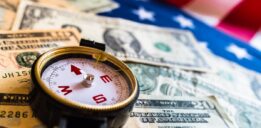2016 GDP Weakest Since Financial Crisis
Fourth-quarter U.S. gross domestic product (GDP) came in a little higher than expected, but it wasn’t enough to bring full-year GDP out of the cellar. The sluggish—nay, stalling—U.S. economy is going to be an issue for President Donald Trump, who, on the campaign trail, said he was going to boost annual GDP to four percent. How? By cutting red tape, slashing taxes, and increasing spending. That’s going to be a tall order. Admittedly, this isn’t Donald Trump’s fault. It isn’t as if he inherited an economy with great momentum. Still, the GDP forecast for the U.S. remains slow and sluggish.
You can’t really say the U.S. economy charged ahead in 2016. The best you can say is it didn’t slow as much as expected. In the fourth quarter, U.S. GDP advanced 2.1%, which is slightly higher than the forecasted 2.0%. It’s down considerably from the 3.5% increase in the third quarter of 2016. (Source: “National Income and Product Accounts Gross Domestic Product: Fourth Quarter and Annual 2016 (Third Estimate),” Bureau of Economic Analysis, March 30, 2017.)
For 2016, U.S. GDP growth was just 1.6%, tied for the worst reading since 2011. The U.S. economy grew 2.6% in 2015. In fact, over the last quarter-century, 2016 ties as the fourth-worst year on record.
There’s just no real excuse for the country’s GDP to be so bad in 2016. In 2001, the year of the 9/11 terrorist attacks, U.S. GDP growth was just 1.0%. In 2008, with -0.3% GDP growth and 2009, with -2.8% GDP growth, the U.S. was in a recession.
Yet, here we are in 2017, nine years into the so-called recovery (and the second-longest bull market in history), U.S. GDP is abysmal, at 1.6%. That didn’t stop Wall Street from crowing about how well the economy is doing, thanks in large part to, I’m told, consumer spending.
But even that is a little rich. The U.S. Department of Commerce said consumer spending, which accounts for roughly 70% of U.S. economic activity, was up 0.1%! That’s half of the 0.2% rise in January and represents the smallest increase since August 2016.
U.S. Economy Back to Normal?
Should we start getting used to subpar economic growth, where GDP of 1.6% to 2.0% is considered strong? It looks like it. According to one Federal Reserve banker, the U.S. economy is back to normal. (Source: “One Fed Official Says the U.S. Economy is Back to Normal,” Fortune, March 30, 2017.)
John Williams, president and CEO of the San Francisco Federal Reserve, said in a speech that the U.S. is the “Goldilocks economy.” Not too hot, not too cold, just right. We know it’s just right because the Fed’s two key metrics, unemployment and inflation, are near the bank’s initial goals. But things are going to get even better: unemployment will fall to around 4.5% by the end of 2017 and inflation will reach two percent in the next year or so.
So why remove some of the easy monetary policies (quantitative easing and artificially low interest rates) that helped jolt the U.S. economy to the lofty heights its enjoying today? On this, Williams said, “Why not just keep our foot on the gas? The answer is that lifting it gradually off the pedal prevents the economy from overheating.” (Source: Ibid.)
Overheating? The U.S. economy is sluggish at best, and raising rates too quickly could undermine fragile U.S. economic growth and bring the long-in-the-tooth bull market to its knees.
In the so-called Goldilocks economy, most of the jobs created since the financial crisis have been low-paying, part-time jobs that offer no security. American household debt is nearing pre-recessionary levels and wage growth is still negligible. 70% of Americans have less than $1,000 in savings, and more than a quarter of Americans have no savings. (Source: “69% of Americans Have Less Than $1,000 In Savings,” GOBankingRates, September 19, 2016.)
The economic activity and jobs needed to support three- or four-percent annual GDP growth simply aren’t there.
Still, Williams believes that the economy is doing very well, so well that the Fed could raise rates more than the projected three times this year. Williams said he would not rule out the possibility of a fourth rate hike.
Williams isn’t alone with his rosy outlook. The New York Federal Reserve says it expects U.S. GDP to grow 2.9% in the first quarter and 2.6% in the second quarter. (Source: “Nowcasting Report,” Federal Reserve Bank of New York, March 31, 2017.)
First-Quarter 2017 GDP to Expand 0.9%
Not all Fed bankers think alike. In the Goldilocks economy, the Atlanta Fed believes the U.S. economy is on track to advance at a 0.9% rate in the first quarter. This is slightly lower than the 1.0% rate calculated in late March, and well below the 3.0%+ rate that the Atlanta Fed expected in January. (Source: “GDPNow,” Federal Reserve Bank of America, March 31, 2017.)
Some on Wall Street have taken a dim view of first-quarter U.S. GDP growth projections too, blaming the downgrade on disappointing consumer spending data. JPMorgan Chase & Co. (NYSE:JPM) lowered its view on first-quarter U.S. GDP to 1.0%, from 1.5%. Barclays PLC (ADR) (NYSE:BCS) economists downgraded their first-quarter GDP outlook to 1.4% from 1.6%, while Goldman Sachs Group Inc (NYSE:GS) analysts followed suit with a first-quarter GDP projection of 1.5% from 1.8%. (Source: “Wall Street lowers Q1 GDP view after weak spending data,” Reuters, March 31, 2017.)
Some at the Fed may believe that the U.S. economy is doing well and can support four rate hikes in 2017 and 2018, but many Americans would disagree. If the U.S. economy is doing as well as the White House and stock market suggests, why are major retailers like Sears, Macy’s Inc (NYSE:M), J C Penney Company Inc (NYSE:JCP), and RadioShack (owned by RS Legacy Corp) doing so poorly? You can’t blame that on late tax refunds. But you can blame it on waning consumer optimism, job uncertainty, and budgets that are stretched thin.
This will continue to be played out on underwhelming GDP growth, which will weigh heavily on Donald Trump’s popularity in the polls. Which, again, you can’t blame entirely on Trump. The average annual GDP growth during Barack Obama’s term as president was just 1.48%, the weakest growth cycle of any expansion since 1949. Obama is also the only president to have never had one year of three-percent GDP growth.
It appears that this sluggish growth trend is going to continue for years to come, in spite of what President Trump has promised.






